Along with Venice and Rome, Florence is one of Italy’s most popular travel destinations. Famous worldwide for its art, culture, history, and architecture.
A city almost 3,000 old, Florence’s story traces the Roman, Byzantine, Medieval, and Renaissance periods of history. Exploring Florence is like walking around the most beautiful outdoor museum.
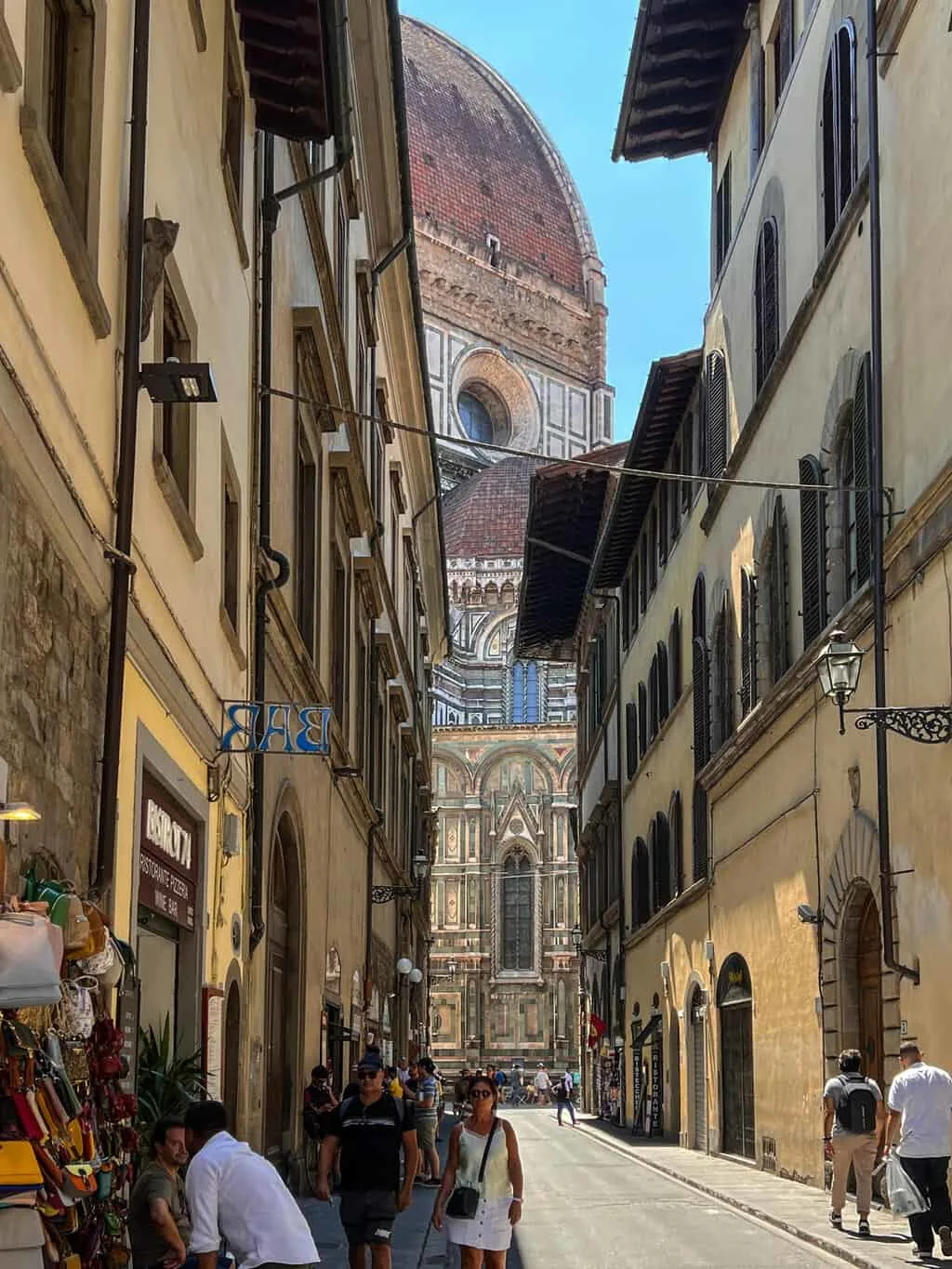
You Might Also Like: The Best Time to Visit Europe for Every Activity and Interest.
Florence is also one of the most romantic cities in Italy and the most beautiful of the north Italian cities. The surrounding Tuscan landscape boasts world-class vineyards and wineries that make an excellent day trip from Florence city. Florence is also a great starting point for a road trip through Tuscany.
There are plenty of exciting things to do and see in Florence. These are some must-see attractions while visiting the beautiful Italian city of Firenze.
Find the Best Accommodation Deals in Florence, from Hotels to Self Contained Apartments
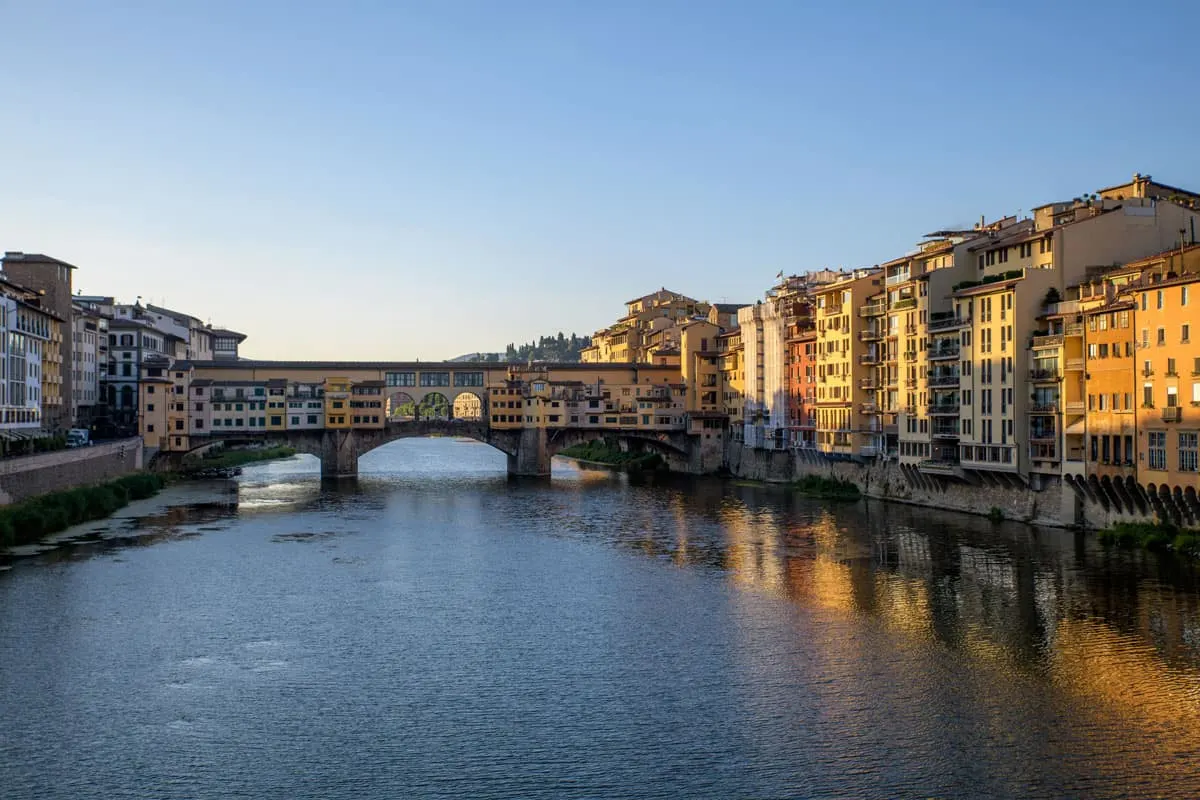
Looking for day trips from Florence? Discover some of the best Food and Wine Tasting Tours in Tuscany from Florence
Must See Attractions in Florence and Things to Do
1. Santa Maria Del Fiori (Florence Cathedral)
It’s impossible to visit Florence without passing by Piazza Del Duomo and witnessing the impressive Santa Maria Del Fiore Cathedral. The majestic Duomo di Firenze is one of Florence’s most popular and famous sights.
Santa Maria del Fiori, one of the ten largest churches in the world, is an architectural wonder finished with beautiful marble. The impressive details of this masterpiece are a true Italian gem.
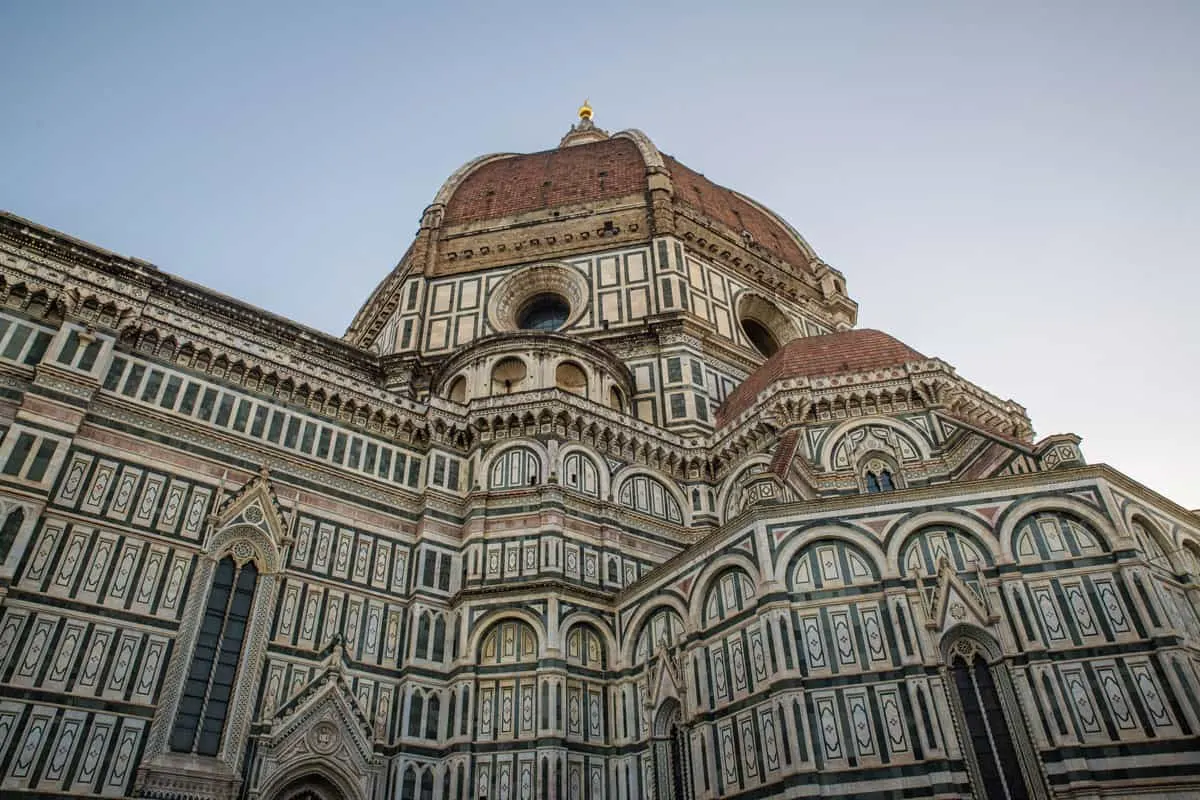
The cathedral is free to visit. However, the dome, bell tower, baptistery, crypt, and museum require a ticket which is valid for 72 hours of purchase.
Be aware the cathedral attractions ticket is not a skip-the-line ticket, and the queue can be notoriously long, especially in summer.
I recommend arriving early or even late in the day once the day tourists have left.
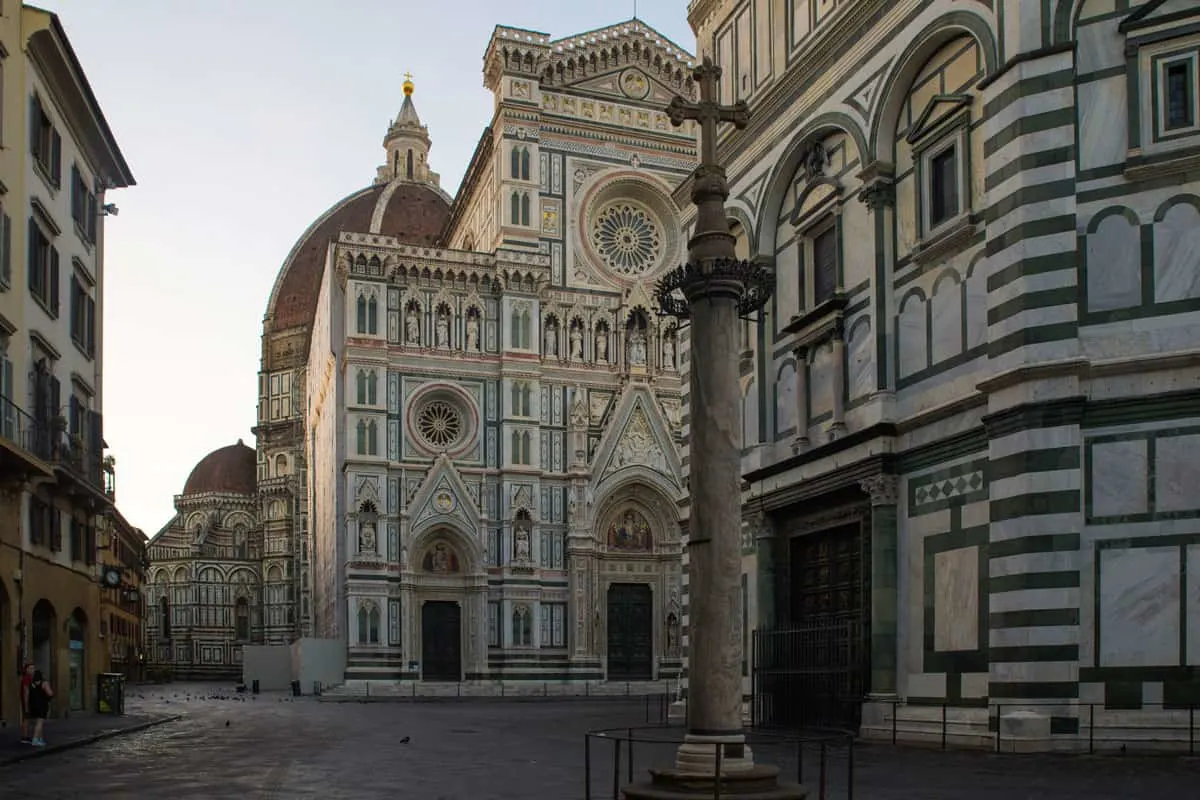
While the church is most impressive from the outside, the dome of the church is quite something and worth the visit. It was the largest free-standing dome in the world until 1881. Climbing the 463 steps to the top provides impressive views of Florence city.
Climbing the dome is included with the 72-hour ticket but requires a reservation, which should be made at least two days in advance in high season.
Tour Tip: You can pre-book a tour with a local guide which gives you skip-the-line access to all the attractions at the Duomo Complex and the Dome climb. It includes all access fees, a headset so you can hear your guide, and pre-booked access to Brunelleschi’s Dome. See here for full Duomo Tour details and reservations.
2. Baptistery San Giovanni
Right outside of Santa Maria Del Fiore, you have the Baptistery of San Giovanni (Baptistery of Saint John). The octagonal building is one of the most important religious buildings in Florence, built in the same style as the cathedral. Constructed between 1059 and 1128 is also one of the oldest buildings in Florence.
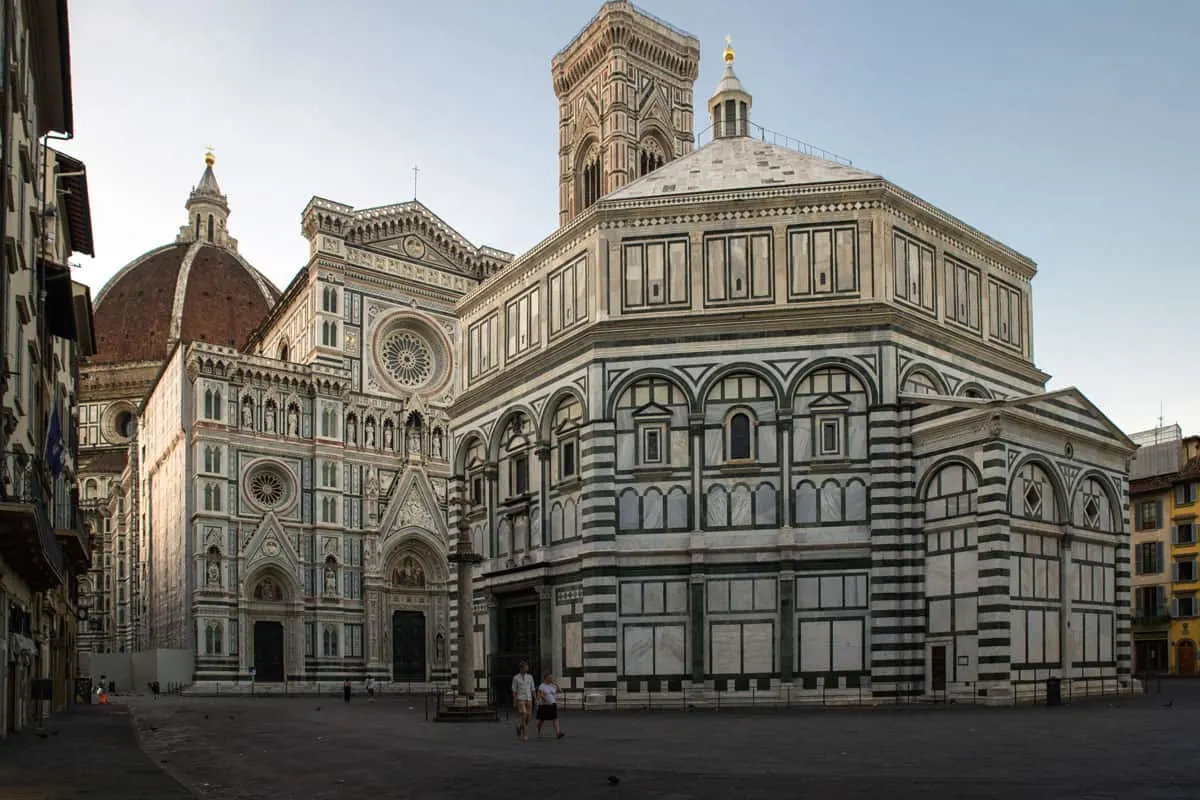
The showstopper of the baptistery is the three sets of artistically important bronze doors with detailed relief sculptures from the Old Testament.
The earliest is the south doors created by Andrea Pisano in 1330, which were originally placed on the eastern side but later moved to make way for the north and east doors by Lorenzo Ghiberti. Michelangelo famously called the east doors the “Gates of Paradise.”
3. Giotto’s Bell Tower
Giotto’s bell tower is one of the four main attractions on the Piazza del Duomo. the 14th-century bell tower is 84.7 meters tall, with 414 steps to the top. While everyone talks about climbing the dome of the Duomo, Giotto’s Tower will give you a birds eye view of the Duomo Dome.
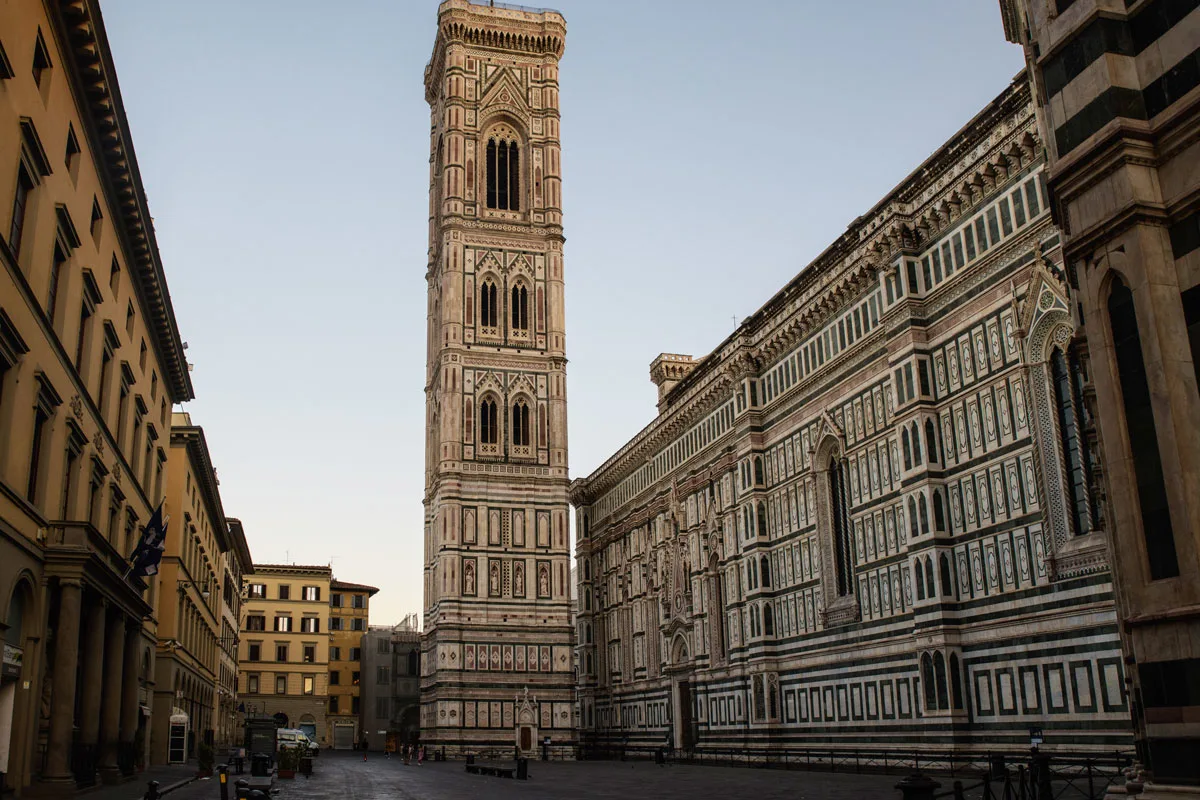
As of 2022, you require a reservation to climb Giotto’s bell tower. You will be given a 45-minute slot to make the climb to the top (there is no lift). This allows plenty of time to climb slowly and enjoy scenic stops along the way.
4. Piazza Della Signoria
Piazza Della Signoria is one of the most beautiful squares in Florence next to Pizza del Duomo.
Famous for the myriad of important buildings and impressive collection of classical art, Piazza della Signoria is a must-see in Florence. While the Piazza del Duomo is the religious center of Florence, the Piazza della Signoria has been the political center of Florence since the 14th century.
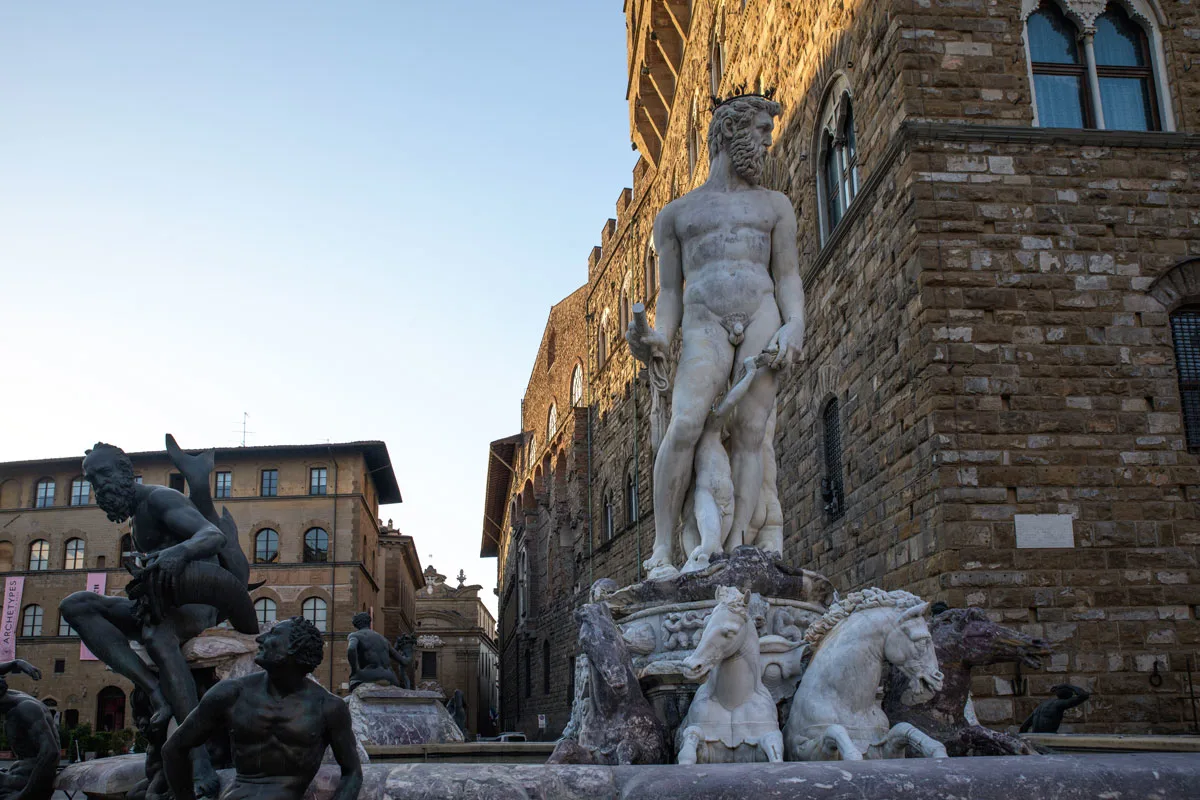
From the magnificent Pallazo Vecchio with its huge clock tower to the incredible display of art, Piazza della Signoria tells us about the triumphs and tragedies of Florence’s most powerful.
Michelangelo’s magnificent statue of David (the original is in the Galleria dell’Accademia), Bandinelli’s Hercules and Cacus, The Nettuno by Ammannati, Giambologna’s equestrian statue of Duke Cosimo I, The statue of Perseo holding Medusa’s head, by Benvenuto Cellini and the Loggia dei Lanzi all mark a moment in Florence’s political history – most tell us about the Republic’s defiance of the tyrannical Medici, or celebrating the Medici’s accomplishments and return to power.
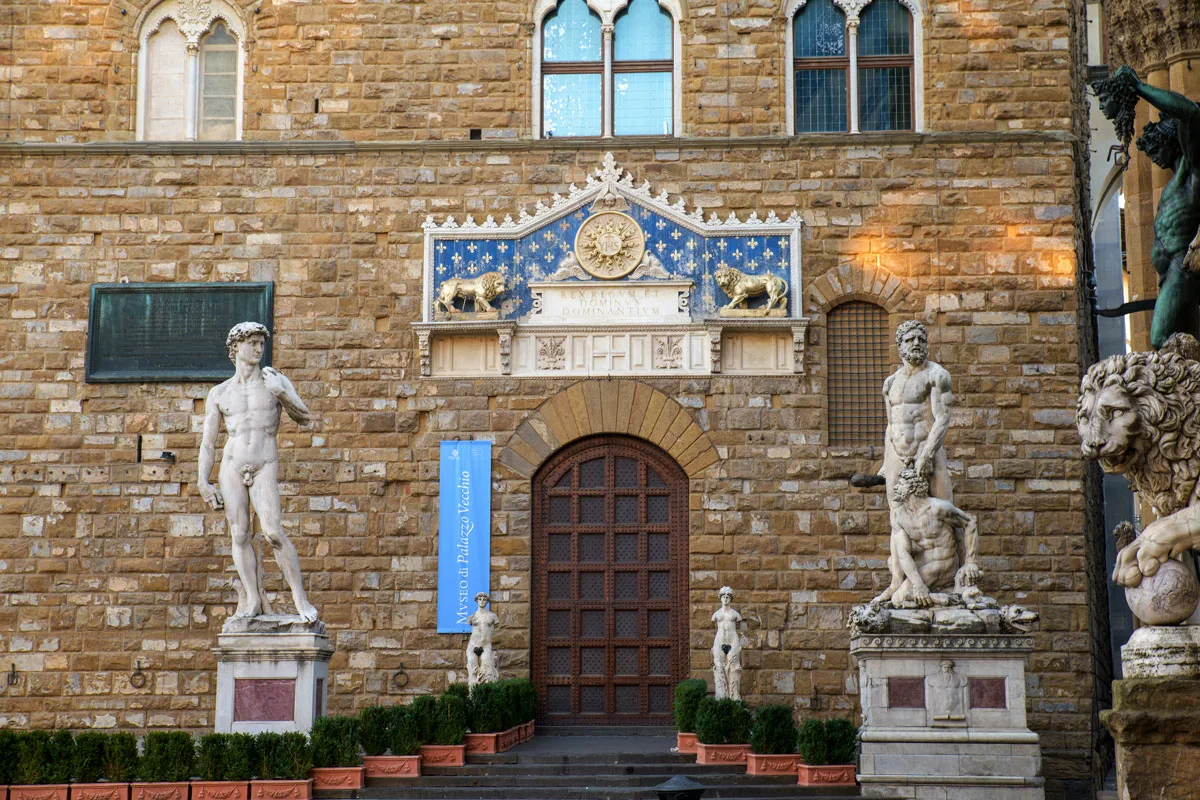
5. Uffizi Gallery
Right next to Piazza Della Signora, is the Gallerie Degli Uffizi. The Uffizi is one of the most important art museums in the world and one of the most visited museums in Florence.
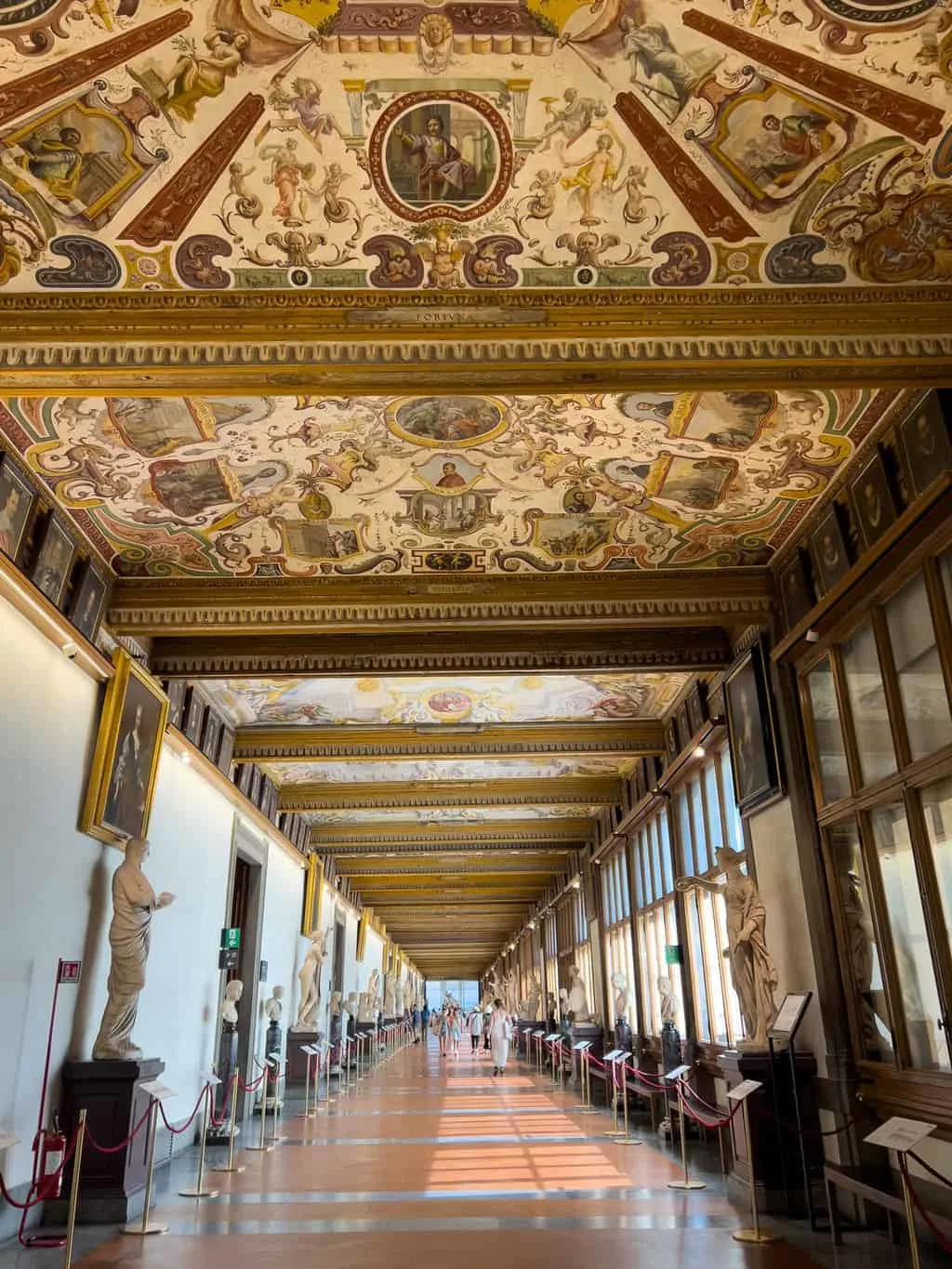
The building, commissioned by Cosimo I de’ Medici in 1560, is a work of art in itself. It was commissioned to replace the Palazzo Vecchio as the administrative center of Florence. In 1581 when the building was completed, Cosimo’s son started a private collection of artworks and sculptures.
The Uffizi now houses one of the most impressive art collections in the world, featuring Greek and Roman statues and some of the most famous works from the Italian renaissance period, such as Botticelli’s Birth of Venus, Annunciation and the Adoration of Magi by Leonardo da Vinci, Raphael’s Madonna del cardellino, the Sacrifice of Isaac by Caravaggio, and Venus Urbino by Titian.
Like the Florence Cathedral, The Uffizi Gallery is one of the most popular attractions in Florence. It is recommended to buy tickets in advance to avoid long queues at the ticket office.
Tip: If you want to skip the crowds at the ticket office, you can pre-book a Uffizi Reserved Timed Entry Ticket which gives you priority access.
6. Palazzo Vecchio
Palazzo Vecchio has been the symbol of civil power in Florence since construction began in 1299. The administrative center of Piazza Della Signoria, Palazzo Vecchio, is one of the most famous and important palaces in Florence.
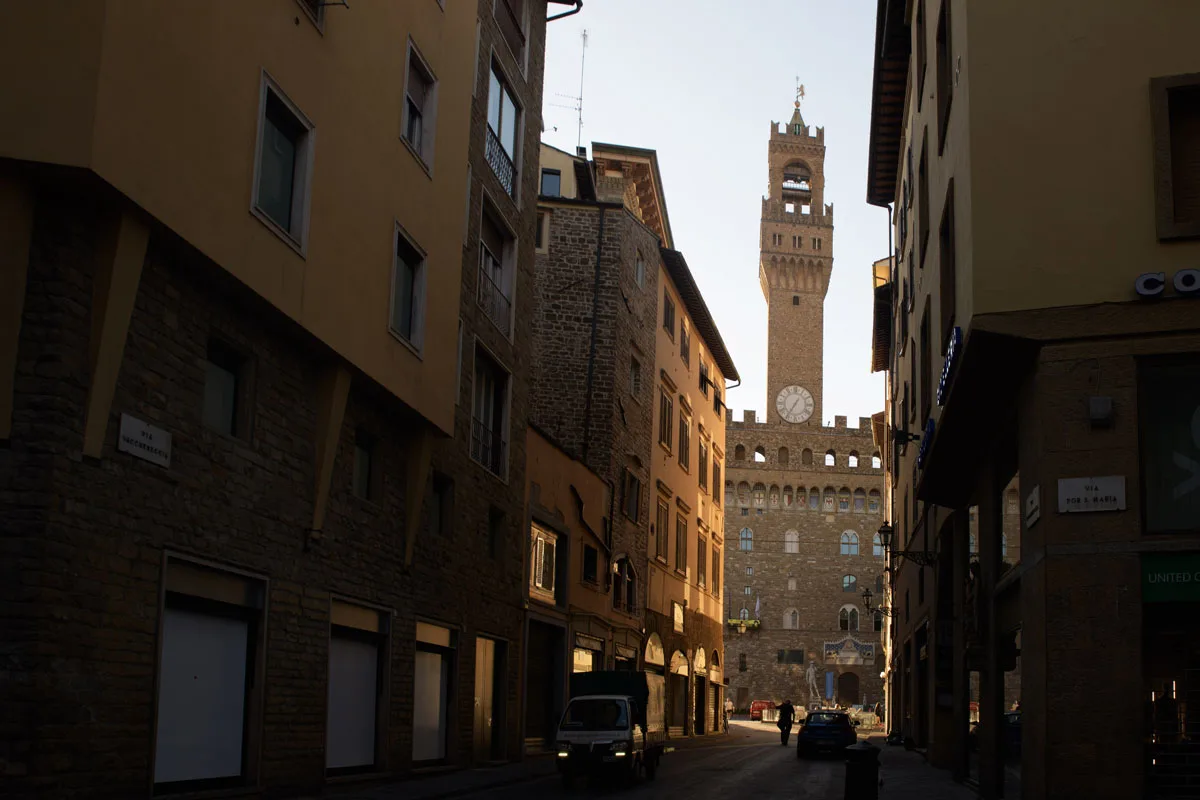
Built in the style of a castle, with a 94-meter-high clock tower that was to warn citizens of Florence of danger, the building still serves as a city hall but also a museum.
The palace has some interesting features, such as secret underground passages and the Salone dei Cinquecento (Hall of the Five Hundred), a room measuring 54 meters long by 22 meters wide and 17 meters high with magnificent frescos by Giorgio Vasari and Michelangelo. Designed to seat 500 people, it is the largest room in Florence.
7. Gucci Garden Museum
Piazza della Signoria is not only a spectacle of Renaissance art, fashionistas can explore Italy’s modern contribution to art and fashion at the Gucci Garden Galleria.
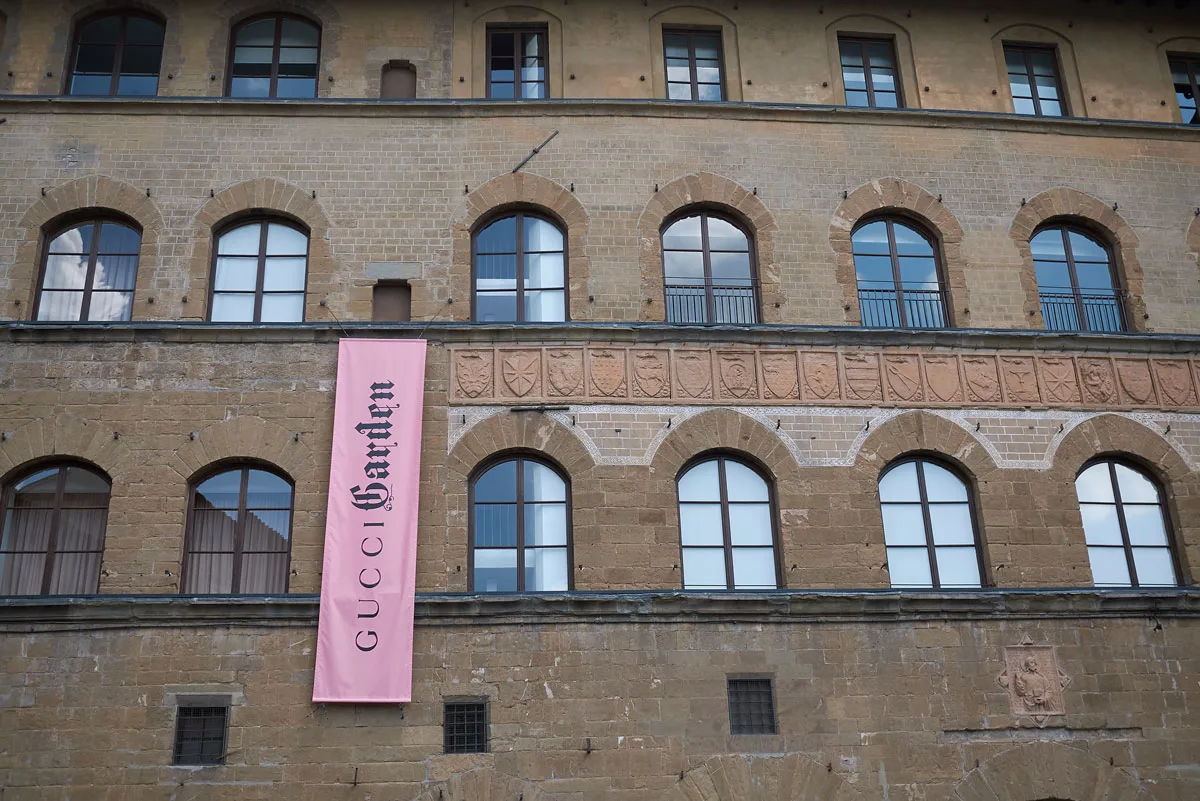
Created in 2011 by Gucci’s current creative director, Alessandro Michele, Gucci Garden explores the vibrant world of Gucci. Exhibitions include the fashion house’s new visions while celebrating the evolution of Gucci since its creation in 1921, including past advertising campaigns.

Behind the historic facade of Palazzo della Mercanzia, the world of Gucci comes to life in a series of themed rooms and exhibitions, including the Gucci Garden Galleria Exhibition rooms and Museum, a Gucci boutique with one-of-a-kind pieces, and the Gucci Osteria da Massimo Bottura restaurant headed up by a three Michelin Star chef.
8. Ponte Vecchio
One of the most iconic attractions and the most famous bridge in Florence is the Ponte Vecchio.
Spanning the river Arno at its narrowest point, the Ponte Vecchio is said to date back to Roman times around 996, but its exact age is unknown.
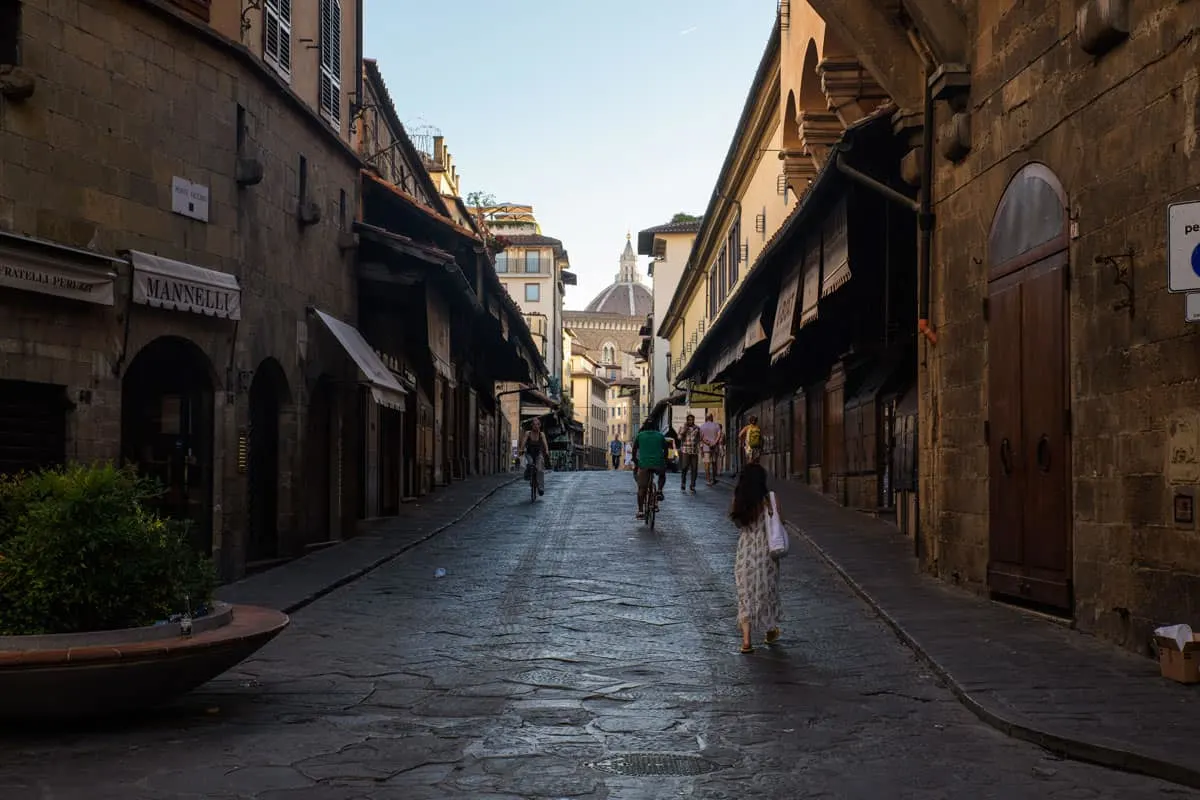
The medieval stone bridge is famous for the shops that line the structure. It was also the only bridge in Florence spared from destruction during WWII.
Placing shops along bridges was once common. Usually, grocers, butchers, or tanners occupied the shops. It is believed the butchers and tanners would throw their rotten waste into the Arno so it would travel downstream to their enemies in Pisa.
Today, the medieval shops on the Ponte Vecchio are occupied mostly by jewelers and art dealers.
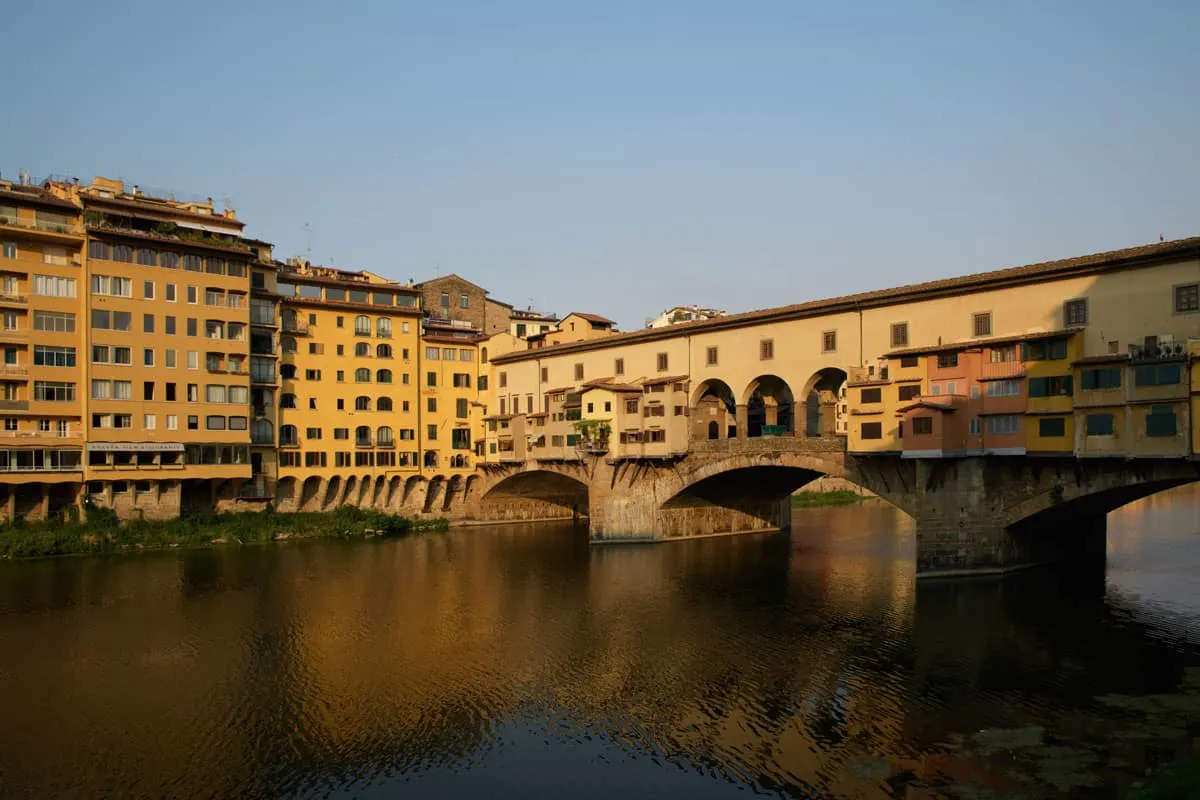
Stroll across to the middle of the bridge, where it opens up to wonderful views down the river Arno.
Take a walk along the Corridoio Vasariano to admire the backs of the shops and houses that seem to hang in mid-air from the exterior of the Ponte Vecchio.
9. Galleria dell’Accademia
Next to the Uffizi, Galleria dell’Accademia is the most important museum in Florence.
The drawcard of the Gallery of the Academy is Michelangelo’s adonis David. A sculpture carved with incredible detail from a single block more than 500 years ago. However, also prepare yourself for one of the most extensive collections of masterpieces in the world.
The museum opened in 1784 as a place where fine arts students could find material to study. It now houses works by great Italian artists of the Renaissance period, such as Michelangelo, Botticelli, Ghirlandaio, Pontormo, Andrea del Sarto, Allori, and Orcagna. Recently, the museum has included a permanent collection of rare and unique musical instruments.
Accademia is a must-see attraction in Florence, but for art enthusiasts, it is essential. Be warned, if you want your moment with David, like the Uffizi, prepare for crowds.
Tip: Book a guided Accademia Gallery tour for priority entry or pre-book your ticket to skip the lines. A Timed Entrance Ticket to Michelangelo’s David gives you priority entrance to the Accademia Gallery and the benefit of a timed entry slot to admire Michelangelo’s David and stay as long as you like in the Gallery.
10. Mercato Centrale
Mercato Centrale is any food lover’s dream and a fun place to spend a few hours. The beautiful cast iron and glass market in the Parisian style dates back to 1874. The two-floor marketplace has vendors selling meat, fish, fresh fruit and vegetables, and local Italian specialties such as cheeses and cured meats, wine, oil, balsamic vinegar, and sweets.
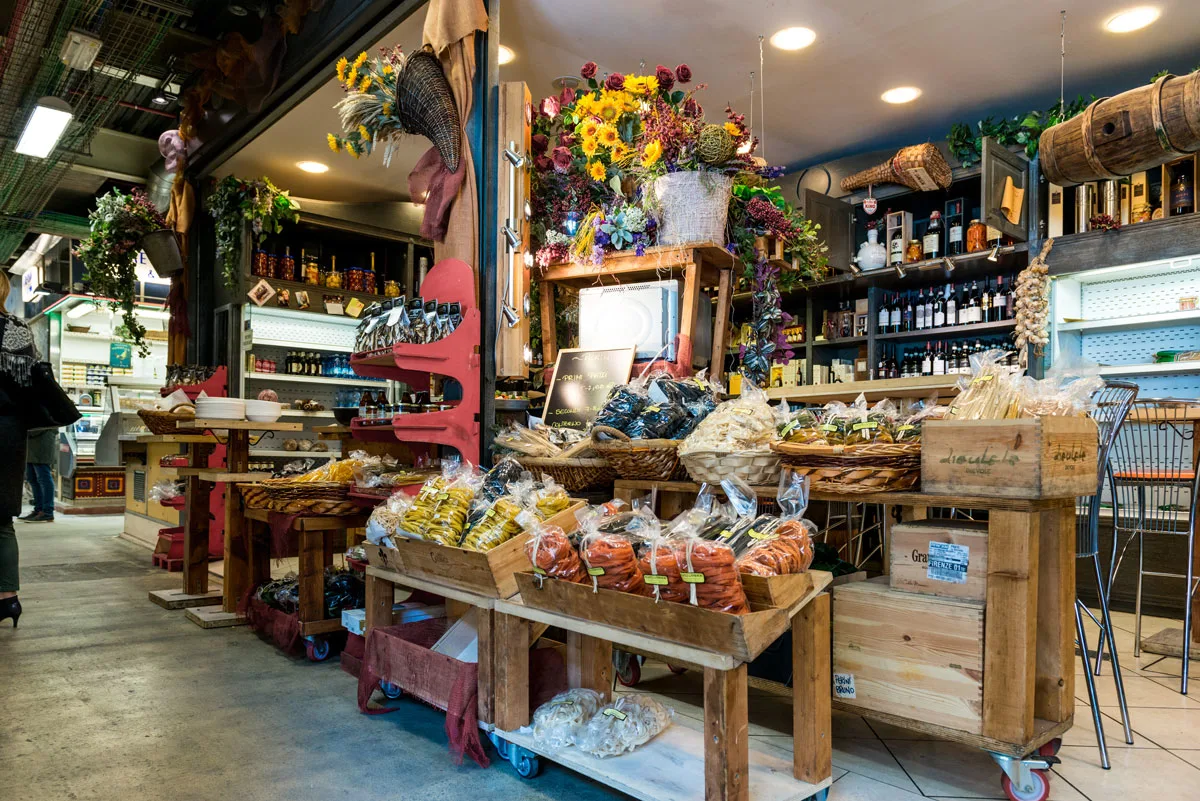
The second floor is now an open food court with street food-style restaurants offering everything from local pizza and pasta to burgers, dumplings, fried fish, and gelato. There’s even a truffle bar and a cooking school.
It gets very busy with tourists and locals popping in for a bite. You can reserve a table but try to aim for times outside of peak lunch or dinner. See Mercato Central for table reservations or upcoming events.
11. San Lorenzo Market
Outside Mercato Central is the open-air San Lorenzo Market. You’ll find vendors selling leather goods such as jackets, handbags and belts, souvenirs, clothing, and pottery. There are all kinds of things for sale at San Lorenzo Market.
Be sure to browse the whole market before making a purchase, don’t be scared to haggle a little, and if you’re in the market for something specific, especially leather goods – ask. Most vendors will have small warehouses nearby where you might find exactly what you’re looking for. It’s a great place to find the perfect Florence souvenir.
12. Basilica De Santa Croce
The Basilica of Santa Croce is another beautiful and historical church in Florence worth a visit.
The largest Franciscan church in the world, the Basilica features sixteen chapels. Basilica de Santa Croce is also known as the Temple of the Italian Glories (Tempio dell’Itale Glorie) as some of Italy’s most illustrious figures are buried there, such as Michelangelo, Galileo, Machiavelli, the poet Foscolo, philosopher Gentile and composer Rossini. Dante and De Vince also have commemorative tombs or plaques there. Legend says that Santa Croce was founded by St Francis himself.
The Santa Croce area is a lovely area to visit for a more local atmosphere. You’ll find some great cafes and restaurants for an evening out away from the touristic center.
13. Piazza della Repubblica
Close to the cathedral, you also find the beautiful Piazza Della Republica. With its central location, it is almost inevitable that you will pass by the historic square.
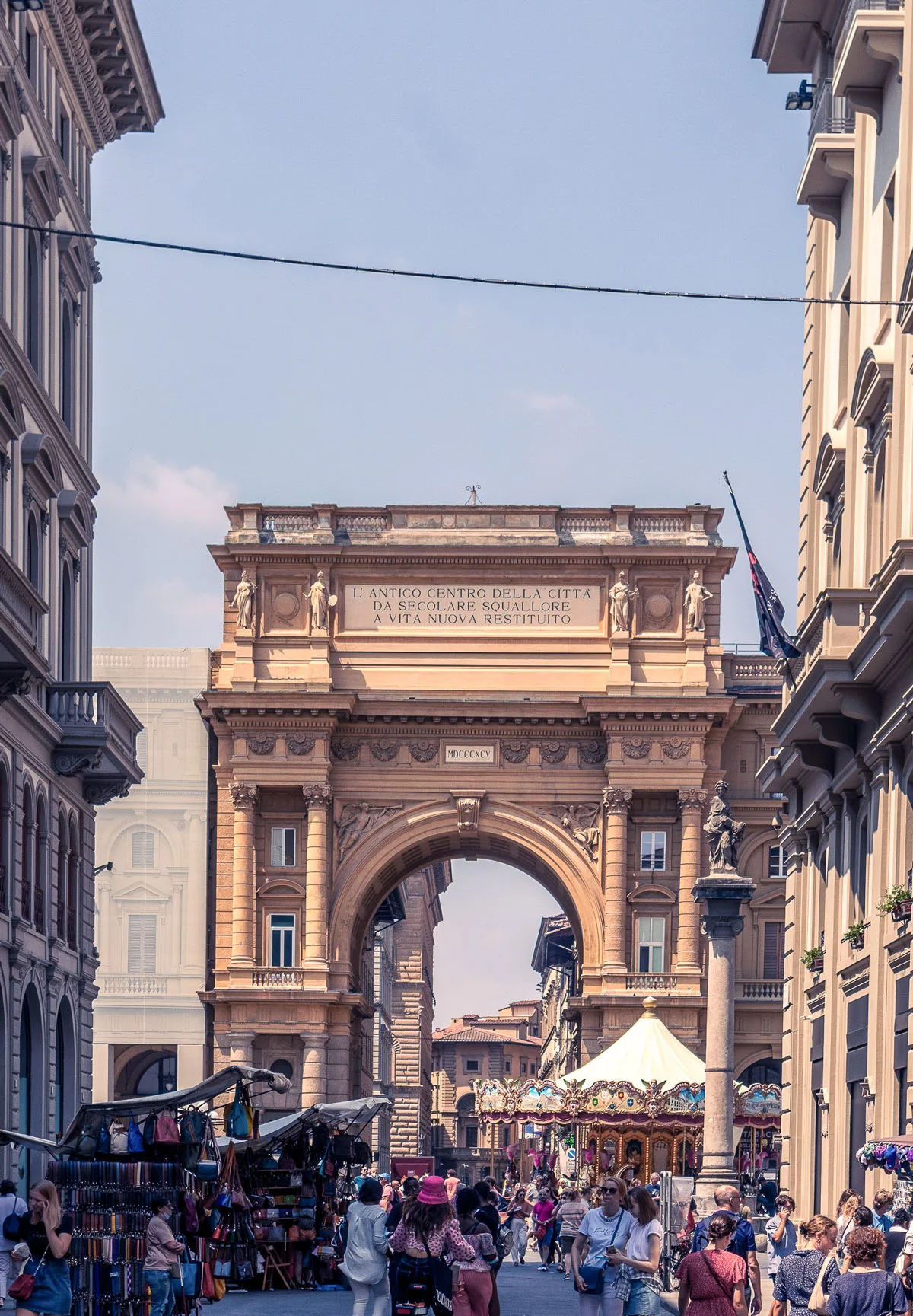
The square’s monumental 15th century column, Colonna dell’Abbondanza (Column of Abundance), is placed at what was the main intersection of the Roman roads making it the center of ancient Roman Florence. Two chains were attached to the column, one was to signal the opening and closing of the ancient market, while the other was used to chain thieves and swindlers for public shaming.
The square is now surrounded by large porticoes with a triumphal arch, charming cafes, and boutiques. There is also a beautiful old carousel that comes to life in the evenings along with street performers.
14. Fontana del Porcellino
Fontana del Porcellino is one of the most popular fountains in the city and one of the more unique attractions in Florence. Locals call it Il Porcellino, meaning little piglet.
The bronze statue of the wild boar was made in 1612 by Pietro Tacca. Il Pocellino was originally meant for the Boboli Gardens but ultimately found its place in the Mercato Nuovo.
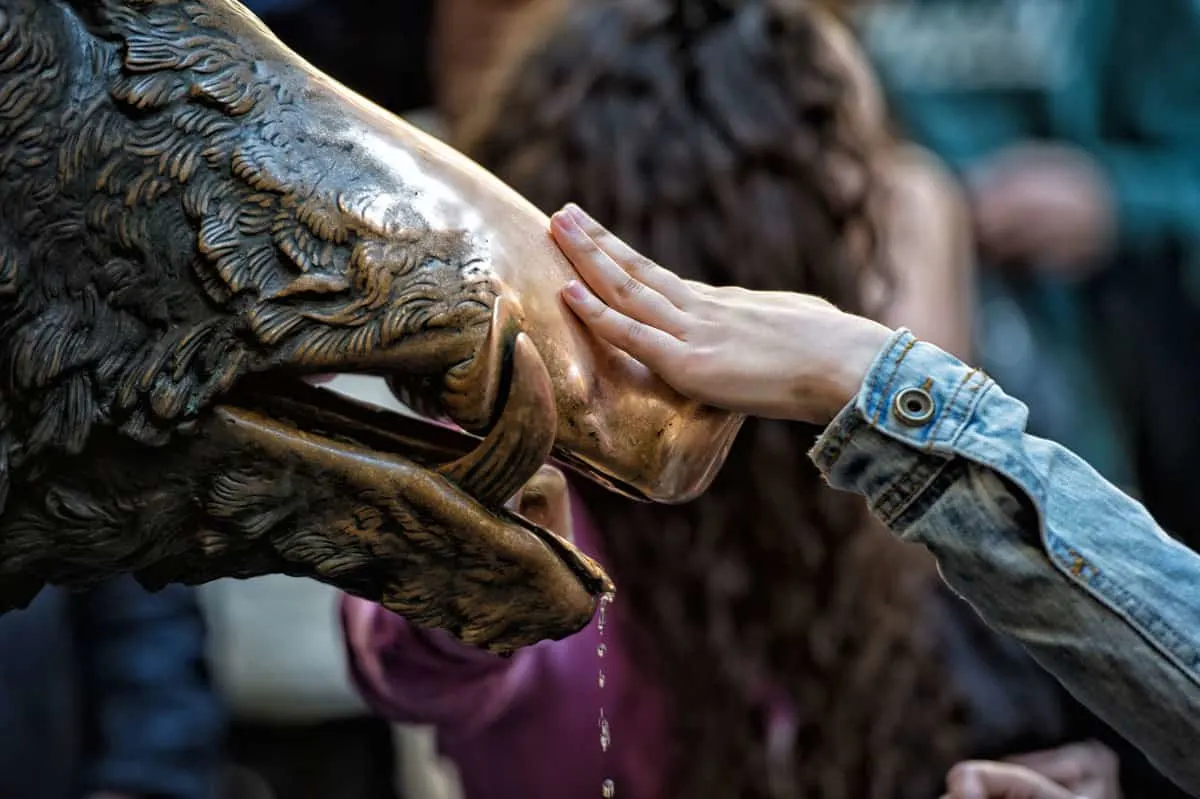
The legend of Il Porcellino is of a wild boar that would turn into a young man every night. On one of his outings, he fell in love with a girl. They wanted to marry, but he had to share his secret on the condition she never told anyone. If she did, he would become a wild boar forever. She didn’t keep the secret, and they were never married.
Today, the legend says if you rub the boar’s nose, you will return to Florence. For luck, place a coin inside the boar’s mouth and let it slide down in the hope it ends up in the grate between its legs. As the coin descends, you can make a wish. The tradition was noted by travelers as early as 1766. Copies of the sculpture can be found all over the world, and it has also featured in literature and movies.
14. Piazzale Michelangelo
For one of the best views of Florence, head to Piazzale Michelangelo. The square itself is not as remarkable as some of Florence’s more famous Piazza’s, but the views are extraordinary.
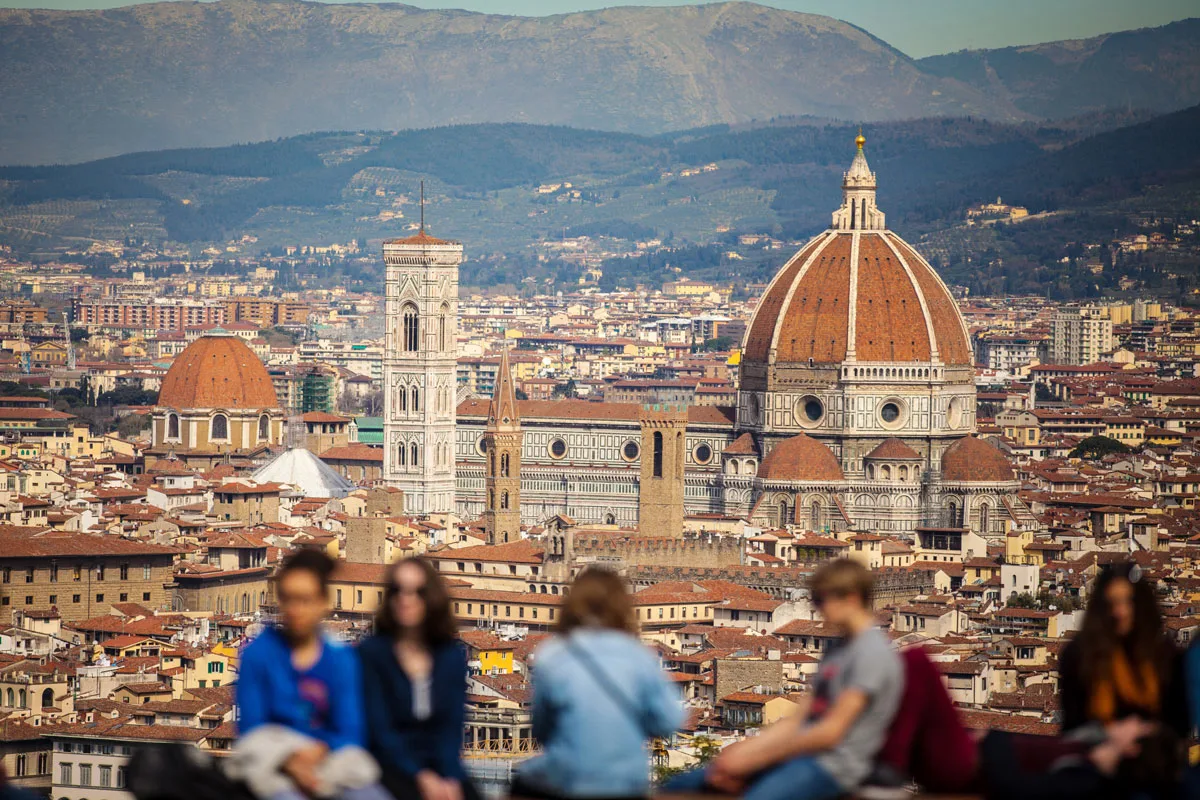
The location is a little out of the center of the city but is well worth the effort. Try to see if you can reach Piazzale Michelangelo for either sunrise or sunset for the best experience.
You can walk up to the Piazzale Michelangelo from the center of Florence or take the number 12 or 13 bus. The red hop on-hop off bus also includes this on its route.
Tip: If you want to get a little active and explore beyond the city center, take a 2 hr City Walking Tour with a Climb to Piazzale Michelangelo for a rooftop view of Florence. See replicas of Michelangelo’s most famous works, including the David. Enjoy a panoramic view high above the city. See the Basilica San Miniato al Monte and Cemetery of the Holy Doors. See here for full details.
15. Pitti Palace and Boboli Gardens
Connected to the Palazzo Pitti, the magnificent Boboli Gardens are an incredible stroke of beauty created by the Medici Family in the 16th century.
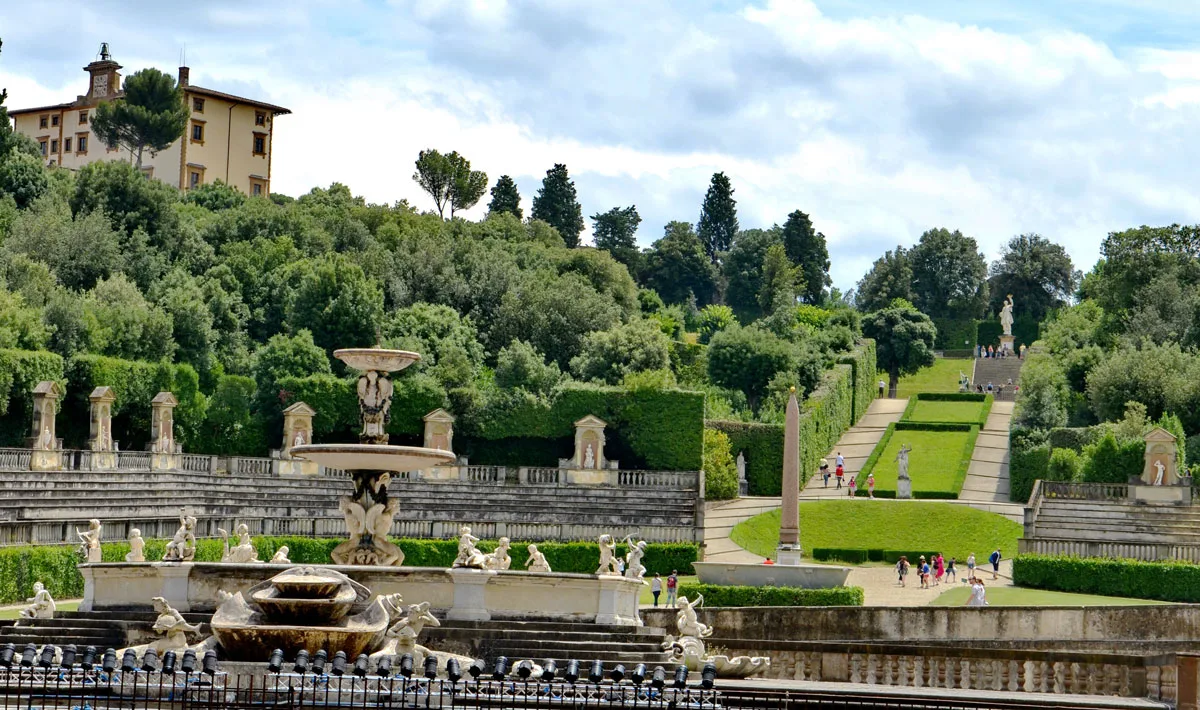
Described as “the Green Lung of Florence,” the gardens cover an area of 45,000 square meters. More like an open-air museum, the gardens are an important cultural site in Florence. Incorporating sculpture centuries-old trees, fountains, and sculptured hedges and trees, the garden became the standard for “green architecture,” which inspired royal courts throughout Europe, including the Palace of Versaille.
Tip: If you want to visit Florence’s most beautiful gardens without the crowds, head to Giardino Bardini. Villa Bardini has magnificent woods, gardens, and fruit orchards to explore with fabulous vistas of the city, which are as culturally important as Boboli. Visit in April to see the magnificent purple display of the wisteria arch.
16. Eat Italian Gelato
No one can visit Italy and not eat proper Italian gelato. As gelato was invented in Florence in the sixteenth century, there’s no better place to try the best.
There are plenty of great gelaterias in Florence to try homemade gelato, including cafe Perché no! which translates to “Why not!” but you can’t miss the oldest and possibly the best gelato shop in Florence at Vivoli Il Gelato.
The cafe was established in 1929, and by 1932, they were bringing blocks of ice from the Apennine mountains (there were no fridges at the time) to start production of artisanal ice cream. The rest is history. You’ll find them at Via Dell’Isola delle Stinche, 7r 50122 Firenze
17. Drink Italian Coffee
Just like gelato, coffee should be enjoyed in Italy too. For one of the best and most traditional coffee experiences, head to Caffe Sabatino dal 1921. This beautiful old Italian café wins with its ambiance and real Italian coffee culture.
Take your cue from the locals and enjoy a quick espresso at the bar. If you want to enjoy the ambiance, sit at one of the bistro tables and maybe indulge in one of their incredible cakes or pastries.
18. Go Out For Aperitivo
One of the most fabulous things about Italy is the Italian aperitivo culture. Basically, this is a mix of snacks and afternoon drinks. In Florence, you have endless possibilities for a great aperitivo. Try the famous negroni that originated in Florence, Caffé Gilli makes one of the best. For the Aperol Spritz lover, visit Bulli e Ballena. Finally, for a great wine experience, Vineria Sonora serves some amazing wines in very cozy Italian surroundings.
About the Author
Josephine Remo
Josephine is a former flight attendant of seven years whose biggest passion is traveling. Having lived in four different countries before age 25, she knows all the tips and tricks for experiencing new cultures. For the past ten years, Josephine has dedicated all her spare time to travel and is currently living as a digital nomad. Josephine writes travel guides and travel tips from places she has visited all over the world on her blog, Josephine Remo.
You can follow Josephine and her journey on Pinterest and Instagram.
